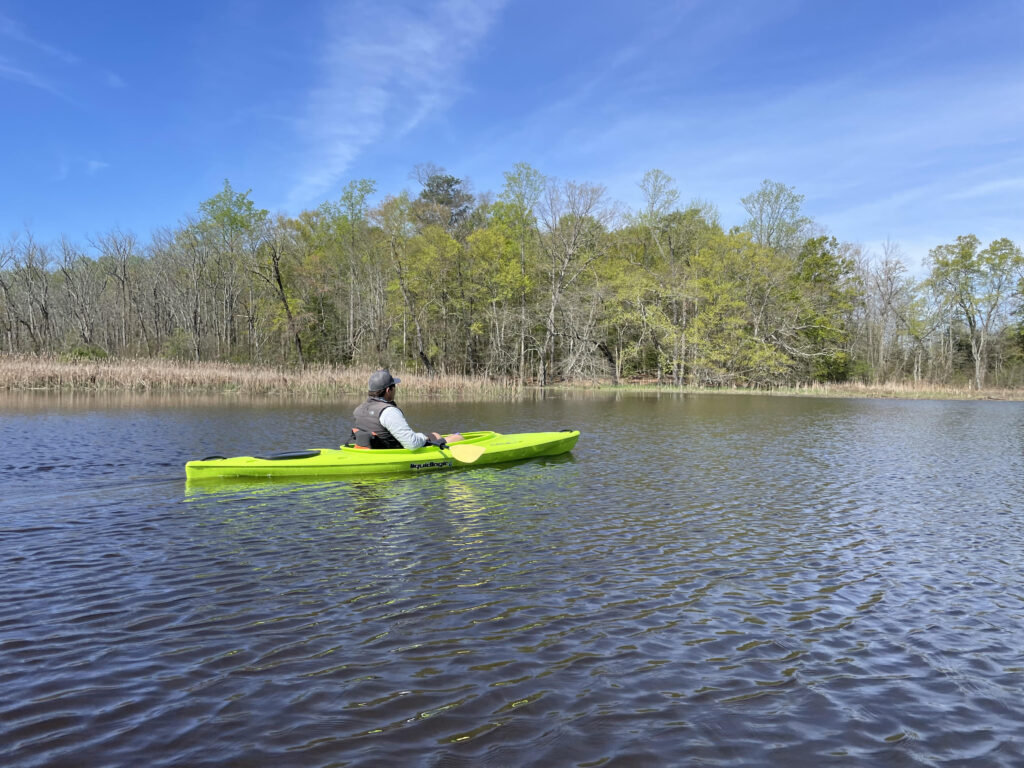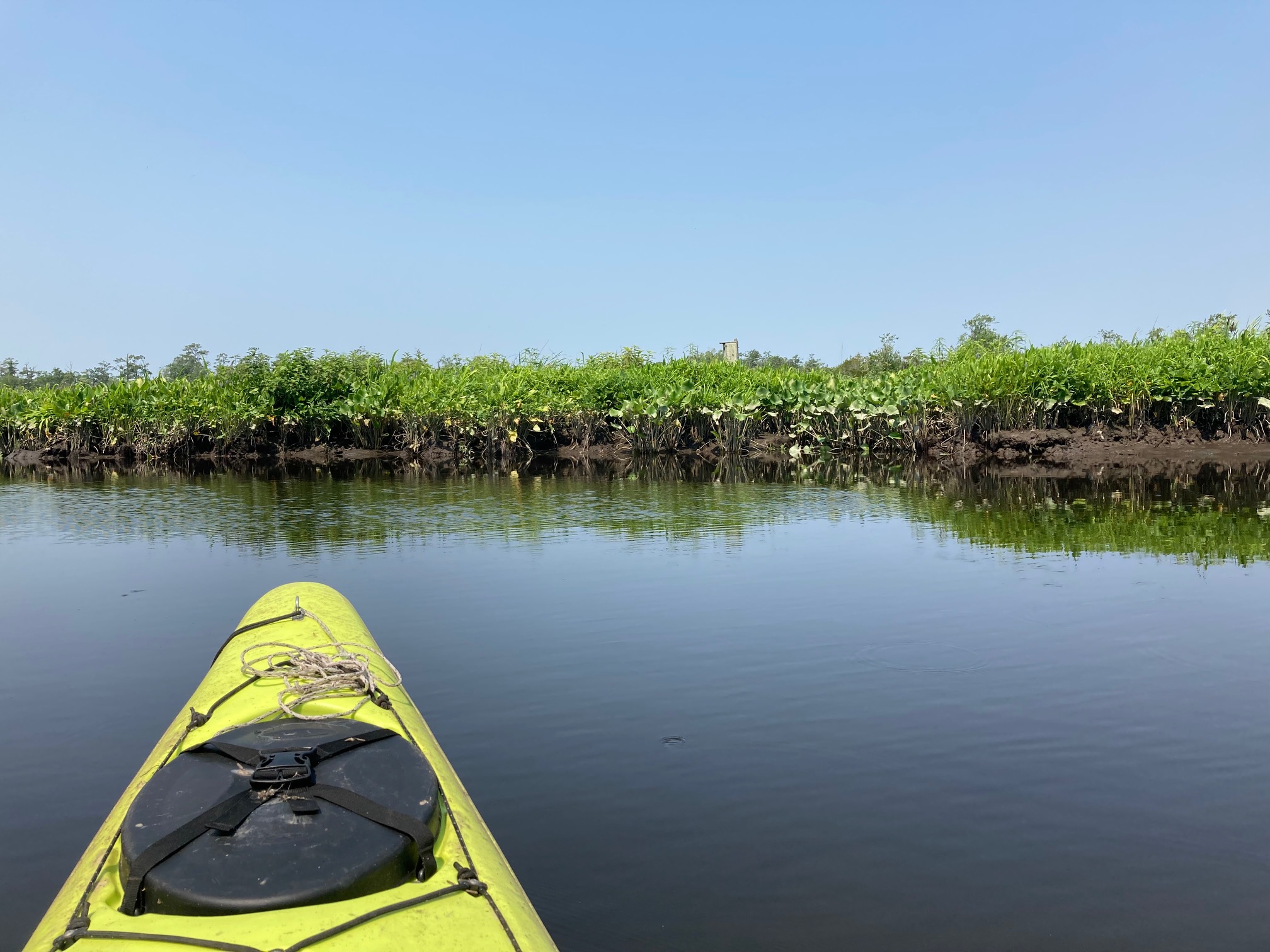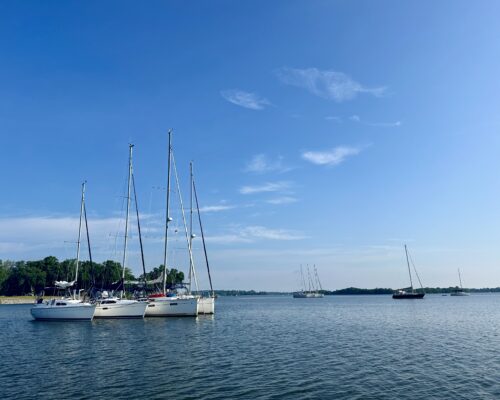David Geller spends most of his days getting other people out on the water in a fleet of kayaks and stand-up paddleboards he rents from his Shore Peddle and Paddle shop in St. Michaels, Maryland. But he made an exception on one of his days off in April to take me on a guided tour of nearby Tuckahoe Creek. He wanted to show me a waterside view of where famed abolitionist Frederick Douglass was born in slavery and where he spent the first years of his youth in the care of his grandmother.
Douglass eventually escaped from slavery and then risked his freedom by becoming an outspoken anti-slavery lecturer, writer and publisher. From his 1881 book, “The Life and Times of Frederick Douglass, Written by Himself,” he wrote:
”My first experience of life, as I now remember it, and I remember it but hazily, began in the family of my grandmother and grandfather, Betsey and Isaac Bailey...My grandmother…was a good nurse, and a capital hand at making nets used for catching shad and herring, and was, withal, somewhat famous as a fisherwoman. I have known her to be in the water waist deep, for hours, seine-hauling…Her little cabin had to me the attractions of a palace. Its fence-railed floor…up stairs, and its clay floor down stairs, its dirt and straw chimney, and windowless sides…The mill-pond, too, had its charms; and with my pin-hook and thread line I could get amusing nibbles if I could catch no fish.”

The Bailey’s cabin is no longer there. In fact, it had disappeared by the time Douglass returned to the site as a revered elder. But Douglass gives enough details in his autobiographies that the general location is easy to assess, and Geller offered to take me there by kayak. I met him at his shop on Talbot Street early one Tuesday.
Geller has been in the business of renting paddle-able boats and pedal-able bikes to visitors for about 10 years now. Most of his clients have seasonal waterfront vacation homes, while others want to explore one of the nearby creeks for the day.

A robust, jovial guy in his 50s, Geller has a background in outdoor education, though he spent most of his career building houses. He grew up in the area and decided he wanted to launch a business where he could get people actively involved in exploring the environment. He lives on the water and spends each morning on his paddleboard, greeting the sunrise from the middle of the Miles River.
But on this day, he was eager to show me the Tuckahoe. I followed his pick-up truck, with the two bright green kayaks propped in the back, as Geller cut through the town of Easton and past farm fields and pastures. The road came to an end at a place called Covey’s Landing near Cordova, where a Talbot County boat ramp provided access to Tuckahoe Creek. There’s an interpretive panel by the boat ramp that tells of Douglass’ local connection.
I was surprised to see how broad the creek was at this point. I’d only seen it further upstream, near Tuckahoe State Park, where it’s much narrower. It flows about 20 miles from above the park there to where it meets the Choptank River about six miles downstream from Covey’s Landing.
The water was smooth and the wind was calm as we launched our kayaks into the middle of the stream. The Tuckahoe is a tidal tributary at this point, and we paddled upstream with the gentle current.
We followed the stream’s languorous bends past marshy islands and wooded banks. We only saw a couple of houses on top of the bluffs in the trees, but we saw plenty of birds—ospreys crash-diving into the water after shad, eagles soaring way up high to avoid the ospreys, enormous great blue herons perching for perch, and for me, a rare close-up glimpse of a long-legged marsh bird called a dunlin, poking its proboscis-like beak into the mud for clams. We passed a huge beaver lodge, but saw no sign of its eager denizens.
Since we were nearly at the height of the tide, we were able to cut corners on the bends in the creek, coasting in inches of water across beds of marsh plants with arrowhead-shaped leaves that were still in the process of sending spring shoots up from the mud. Later, I learned that these plants are called arrow arum by botanists. The native Americans who lived here called them “Tuckahoes.” Eventually, Dave guided us into a side creek off to the left. We followed its bends as it narrowed until we were blocked by a fallen tree. This is as close as anyone can get to the site of Douglass’ grandparents’ cabin.
I could envision the little boy tagging along with Betsey Bailey as she stretched her nets across the mouth of the creek, or pinning a worm on a string to try for “some amusing nibbles,” if not a fish. Douglass gives us a glimpse of an idyllic life as a young boy, one which changed abruptly when he was farmed out to work at the estate of Edward Lloyd V. That’s where he learned what it meant to be a slave. That’s where he first witnessed the unspeakable cruelty of the institution he later fought so valiantly to destroy.
We made our way back to Covey’s Landing, having paddled about five miles round trip. One nice thing about this section of the creek is that the current is so gentle, even with the tide, you can easily paddle upstream and down and return to where you put in.
Most of Geller’s clients launch their rented kayaks on Santo Domingo Creek along the southern edge of St. Michaels, where they can paddle through the marshes and explore the little islands of Broad Creek.
There are dozens of other put-in sites where you can launch your car-top boat, and Talbot County presents some of the best in their St. Michaels and Tilghman Island water trails maps. These trails provide well-mapped excursions ranging from quick loops in protected coves to longer cruises along the open Bay shoreline. Pick one that fits your time frame and go exploring, whether you’re an experienced paddler or still trying to figure out which pointy end goes first.
Printed on glossy, waterproof paper, the maps are available both online and at the Talbot County Visitors Center in Easton. Each trail includes driving directions to the launch site, the distance covered and the suggested time allocation, along with cautions about the tidal currents, wind, weather and boat traffic conditions you can expect to encounter, plus helpful tips on local landmarks and wildlife you’re likely to see.
A separate water trail guide published by the National Park Service’s Chesapeake Gateways and Waterways Program, shows how to access Tuckahoe Creek on Talbot County’s eastern border. Section 5 of the Choptank and Tuckahoe Rivers Water Trails Map Guide covers the Tuckahoe from Hillsboro Landing to Covey’s Landing. You can download a map from https://www.findyourchesapeake.com/places/trails/choptank-tuckahoe-rivers-water-trail.
The water trail maps are an excellent source of other information you can use to plan your explorations of Talbot County’s 600 miles of shorefront along the Chesapeake Bay, the rivers and creeks, time and again.
You can find a number of kayak, boat and bike rentals in Talbot County at https://tourtalbot.org/tt_business_services/kayaks.
Explore Frederick Douglass’ Life in Talbot County by Car
Start at the Talbot County Courthouse in historic downtown Easton, Maryland. There you’ll find a statue of Douglass sculpted by Jay Hall Carpenter to commemorate the abolitionist’s “Self-Made Men” speech he delivered in the main courtroom in 1878.
This is one of many sites on not just one, but four self-guided driving tours, each hour-long tour depicting a separate era of the great orator’s early life and his return to the area in his later years. You can find these at www.frederickdouglassbirthplace.org.
You’ll also find directions to Frederick Douglass Park on the bank of Tuckahoe Creek, established in 2018 in honor of the 100th anniversary of his birth. It’s located at 13213 Lewistown Road near the town of Queen Anne. You can see several interpretive panels as well as a view of the creek from atop a bluff not far from his supposed birthplace.




